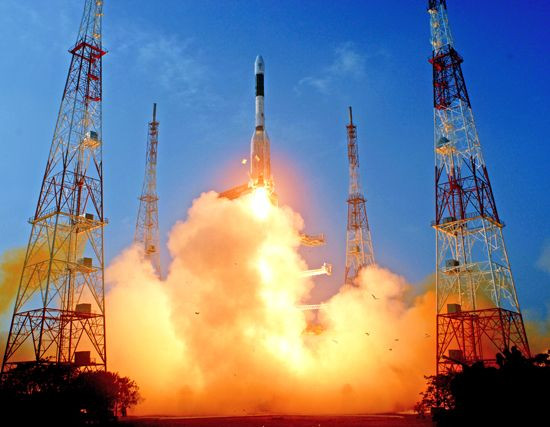India Successfully Launches Indigenous Cryogenic Engine-Powered GSLV-D5 Rocket; Promising Start To Future Of Manned Spaceflight Program

The Indian Space Research Organization, or ISRO, launched its GSLV-D5 rocket, powered by an indigenous cryogenic engine, on Sunday from the Satish Dhawan Space Centre in Sriharikota, about 62 miles north of the southern Indian city of Chennai.
According to the ISRO, 17 minutes after the rocket lifted off at 4:18 p.m. local time (5:48 a.m. EST), it successfully launched GSAT-14, a communication satellite, into geosynchronous transfer orbit, or GTO. Immediately after the satellite launch, the ISRO's Master Control Facility at Hassan in Karnataka took over the control and command of GSAT-14. The project's scientists said the flight's crucial phases were executed as planned, making it a successful launch.
“The launch has been so precise that the satellite was put just 40 meters within the 179km perigee and only 50km of the 36,000km apogee,” K. Sivan, project director of GSLV, was quoted by local media reports as saying.
With the successful launch of the GSLV-D5 rocket, India has become only the sixth nation after the U.S., Russia, Europe, China and Japan to develop a cryogenic engine -- a rocket engine that uses a cryogenic fuel or oxidizer, which are gases liquefied and stored at very low temperatures. The launch also takes India one step closer to the successful execution of a manned mission into space in the future.
Sunday’s launch followed two failed GSLV flights by ISRO. In April 2010, the organization had tested its first indigenous cryogenic engine, which failed in less than a second after the cryogenic stage ignited. ISRO then attempted to launch a refurbished GSLV-D5 in August 2013, but a leak in the liquid fuel tank forced it to abort the mission two hours before the rocket was scheduled to lift off.
ISRO had used up six of the seven cryogenic engines it received from Russia, when supply of Russian material dried up in the early 1990s due to U.S. pressure, forcing India to develop its own cryogenic engine.
According to K. Radhakrishnan, chairman of the ISRO, India began working on the idea of developing its own cryogenic engine in the late 1960s, but a decision to go ahead with it was made only in 1992, media reports said.
© Copyright IBTimes 2024. All rights reserved.






















